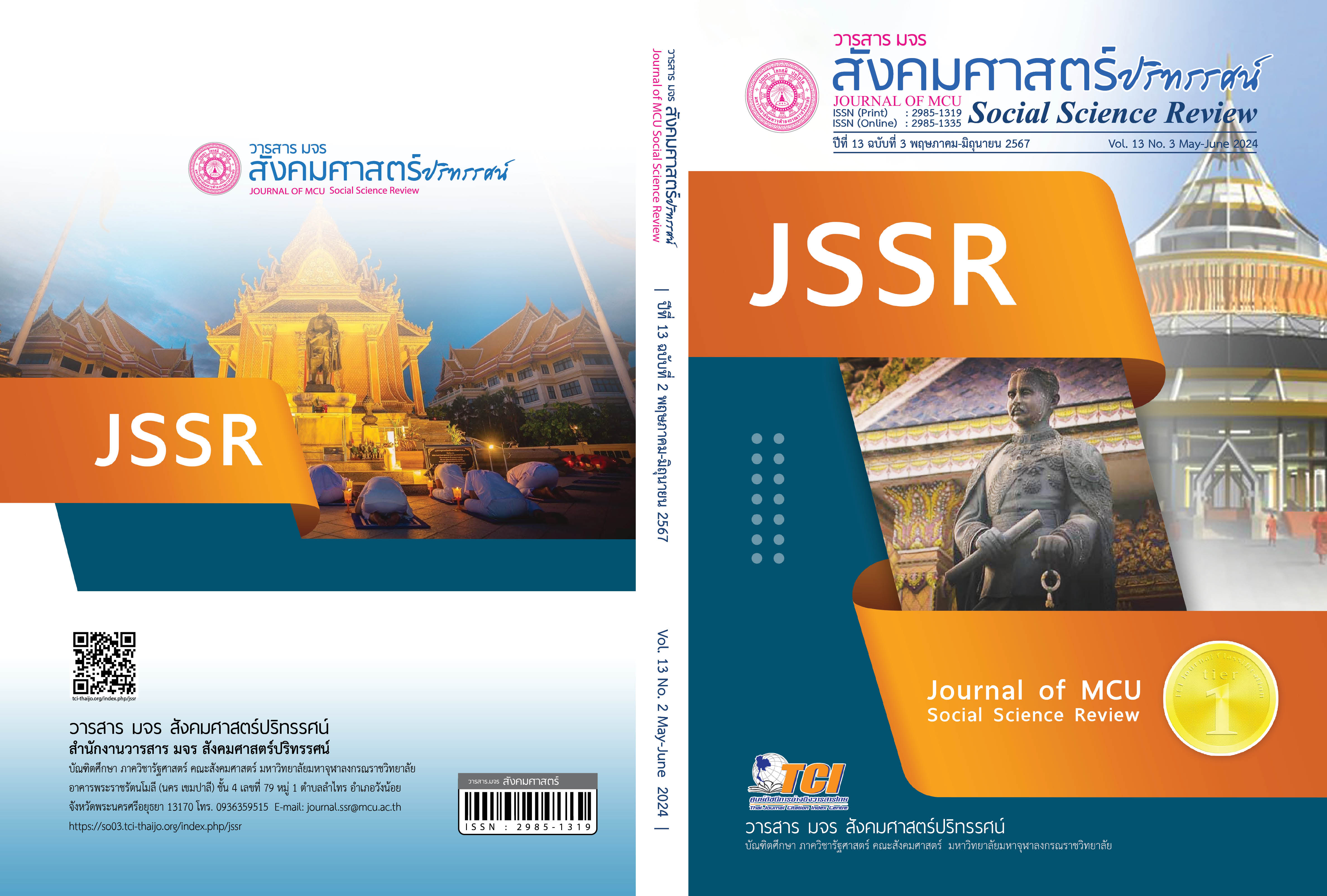ความเสี่ยงต่อความรุนแรงในครอบครัว ตำบลเขวา อำเภอเมือง จังหวัดมหาสารคาม
คำสำคัญ:
ความเสี่ยง, ความรุนแรง, ครอบครัว, มหาสารคามบทคัดย่อ
บทความวิจัยนี้มีวัตถุประสงค์ 1. ศึกษาลักษณะส่วนบุคคลของกลุ่มตัวอย่าง 2. ศึกษาระดับความเสี่ยงต่อความรุนแรงในครอบครัว 3. ศึกษาเปรียบเทียบความแตกต่างระหว่างลักษณะบุคคลกับสภาพปัญหาที่เป็นความเสี่ยงต่อความรุนแรงในครอบครัว ตำบลเขวา อำเภอเมือง จังหวัดมหาสารคาม ใช้การวิจัยเชิงปริมาณ กลุ่มตัวอย่างในการศึกษาวิจัยครั้งนี้ จำนวน 105 คน เครื่องมือที่ใช้ในการวิจัย ได้แก่ แบบสอบถาม วิเคราะห์ข้อมูลโดยการพรรณนาความ สถิติที่ใช้ในการวิเคราะห์ ได้แก่ ค่าความถี่ ค่าร้อยละ ค่าเฉลี่ย ค่าเบี่ยงเบนมาตรฐาน ค่าสูงต่ำและสถิติทดสอบความแตกต่าง ได้แก่ Independent t-test และ One-Way ANOVA
ผลการวิจัยพบว่า 1. ผู้ให้ข้อมูลส่วนใหญ่เป็นเพศหญิง ร้อยละ 90.50 ช่วงอายุ 51-59 ปี ร้อยละ 49.50 ใช้ชีวิตคู่ครั้งแรกช่วงอายุ 20-30 ปี ร้อยละ 59.00 สถานะสมรส ร้อยละ 92.38 ใช้คู่ชีวิต 1 ครั้ง ร้อยละ 92.38 ระดับการศึกษาต่ำกว่าระดับระดับมัธยมศึกษา ร้อยละ 60.95 ประกอบอาชีพเกษตรกร ร้อยละ 80.00 รายได้ต่ำกว่า 5,000 บาท ร้อยละ 64.76 ใช้แอพพลิเคชั่นไลน์ ร้อยละ 73.33 มีและไม่มีทะเบียนสมรสจำนวนเท่า ๆ กัน 2. ระดับความเสี่ยงต่อความรุนแรงภาพรวมในครอบครัวมีค่าเฉลี่ย เท่ากับ 1.90 (0.58) ระดับน้อย 3. ลักษณะส่วนบุคคลมีระดับความเสี่ยงต่อความรุนแรงในครอบครัวที่แตกต่างกันอย่างมีนัยสำคัญทางสถิติ (P Value< 0.05) ได้แก่ ช่วงอายุกับด้านเศรษฐกิจ ระดับการศึกษากับด้านสังคมและด้านเศรษฐกิจ สถานะภาพสมรสกับด้านสังคมและการมีทะเบียนสมรสกับด้านเศรษฐกิจ
เอกสารอ้างอิง
กรมการปกครอง. (2562). จำนวนประชากรสมรสและหย่าร้าง. สืบค้น 20 เมษายน 2563, จาก www.dopa.go.th
จุฬาลักษณ์ ประจะเนย์ และคณะ. (2558). รูปแบบการสื่อสารภายในครอบครัว รูปแบบการ ดำเนินชีวิต รูปแบบความผูกพันภายในครอบครัวที่มีต่อพฤติกรรมการใช้เครือข่ายสังคมออนไลน์และการติดเกมของวัยรุ่นในเขตกรุงเทพมหานคร. วารสารพฤติกรรมศาสตร์, 21(1), 175-191.
ภัสสร ลิมานนท์. (2544). เพศ สถานภาพสตรีกับการพัฒนา. กรุงเทพฯ: จุฬาลงกรณ์มหาวิทยาลัย.
ศุภลักษณ์ จันทร์เจริญ. (2542). ปัจจัยที่มีผลต่อความรุนแรงในครอบครัว (รายงานการวิจัย). กรุงเทพฯ: กรมประชาสงเคราะห์.
สุภาวดี น้อยมณี. (2558). การสำรวจสถานการณ์เสี่ยงต่อความรุนแรงในครอบครัวในตำบลแม่ยางฮ่อ อำเภอร้องกวาง จังหวัดแพร่ (วิทยานิพนธ์สังคมสงเคราะห์ศาสตรมหาบัณฑิต สาขาวิชาการบริหารและนโยบายสวัสดิการสังคม). ปทุมธานี: มหาวิทยาลัยธรรมศาสตร์.
องค์การบริหารส่วนตำบลเขวา. (2562). แผนพัฒนาท้องถิ่น (พ.ศ. 2561-2565) องค์การบริหาร ส่วนตำบลเขวา อำเภอเมือง จังหวัดมหาสารคาม. สืบค้น 25 เมษยาน 2561, จาก https://shorturl.asia/ILT0k
อังคณา ช่วยค้ำชู. (2555). ความรุนแรงในครอบครัว : สาเหตุ ผลกระทบ และแนวทางการช่วยเหลือ. วารสารธรรมศาสตร์, 31(3), 130-145.
Best, John W. (1977). Research in education (3rd ed.). New Jersey: Prentice Hall.
Wade, M. V. (2006). Likert-type scale response anchors. Clemson International Institute for Tourism & Research Development. Recreation and Tourism Management: Clemson University.
ดาวน์โหลด
เผยแพร่แล้ว
รูปแบบการอ้างอิง
ฉบับ
ประเภทบทความ
สัญญาอนุญาต
ลิขสิทธิ์ (c) 2024 วารสาร มจร สังคมศาสตร์ปริทรรศน์

อนุญาตภายใต้เงื่อนไข Creative Commons Attribution-NonCommercial-NoDerivatives 4.0 International License.
เพื่อให้เป็นไปตามกฎหมายลิขสิทธิ์ ผู้นิพนธ์ทุกท่านต้องลงลายมือชื่อในแบบฟอร์มใบมอบลิขสิทธิ์บทความให้แก่วารสารฯ พร้อมกับบทความต้นฉบับที่ได้แก้ไขครั้งสุดท้าย นอกจากนี้ ผู้นิพนธ์ทุกท่านต้องยืนยันว่าบทความต้นฉบับที่ส่งมาตีพิมพ์นั้น ได้ส่งมาตีพิมพ์เฉพาะในวารสาร มจร สังคมศาสตร์ปริทรรศน์ เพียงแห่งเดียวเท่านั้น หากมีการใช้ภาพหรือตารางหรือเนื้อหาอื่นๆ ของผู้นิพนธ์อื่นที่ปรากฏในสิ่งตีพิมพ์อื่นมาแล้ว ผู้นิพนธ์ต้องขออนุญาตเจ้าของลิขสิทธิ์ก่อน พร้อมทั้งแสดงหนังสือที่ได้รับการยินยอมต่อบรรณาธิการ ก่อนที่บทความจะได้รับการตีพิมพ์ หากไม่เป็นไปตามข้อกำหนดเบื้องต้น ทางวารสารจะถอดบทความของท่านออกโดยไม่มีข้อยกเว้นใดๆ ทั้งสิ้น





